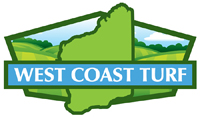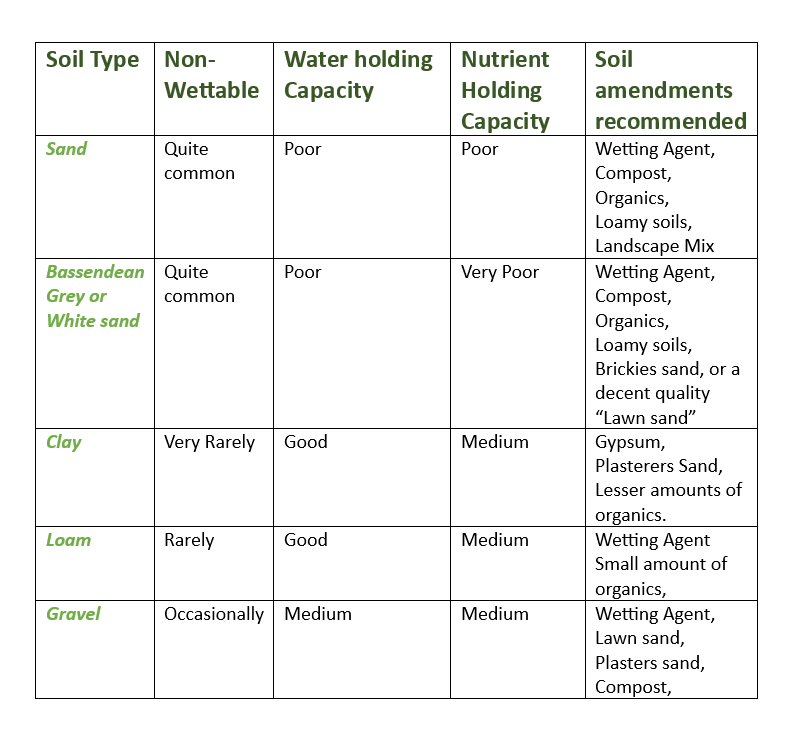Thankyou to Ken Johnston and Peter Ruscoe from Sports Turf Technology for all the information found on this page.
Soil amendment quick guideSoil Amendments
Perth and surrounding suburbs soils
The majority of the Perth metropolitan area is situated on the Swan Coastal Plain. This is a narrow strip of land ranging from 15 to 30 km wide, extending from Jurien Bay in the north to Busselton in the south. It lies between the Indian Ocean to the west and Darling Range to the east.
The Perth metropolitan area has developed around the Swan and Canning rivers, which flow only during the winter months due to strong seasonal rainfall, and are tidal almost to the foothills.
The Swan Coastal Plain consists almost entirely of soils deposited by wind and water. The major soil systems have been formed in a pattern roughly parallel to the coastline.
The eastern section of the plain is composed mainly of loamy alluvial material deposited by erosion from the scarp. The central and western areas stretching to the coast comprise a series sand dune systems.
Most of the soils on the Swan Coastal Plain are relatively infertile, lacking organic matter and essential plant nutrients. The sandy soils also have poor water holding capacity due to the very low clay content and tend to be highly water repellent in the surface layer.
Soil types in the Perth region can be divided into.,
Coastal;
Western Coastal;
Central Coastal;
Eastern Coastal; and
Foothills, Scarp and Hills.
COASTAL
This term applies to the entire system of coastal calcareous sand dunes. It is also known as the Quindalup dune system.
These sands originated as sediment on the ocean floor, which were washed onto the beach and then blown inland, forming an extensive system of high, steep-sided dunes.
The Coastal system is typically deep, white sand containing 20-40% fine-grained limestone.
The Swan Coastal Plain began to form when India drifted away from the west coast, 65 to 136 million years ago. The oldest soils lie in the east, while the coastal dunes al Bold Park are only about 6500 years old.
These sands have a low to moderate phosphorus retention capacity depending mainly on the amount of iron oxide coating the sand grains. In general, the phosphorus retention capacity increases from the cream to the yellow sands through to the orange and brown sands.
The brown and orange sands have slightly higher clay contents than the cream and yellow sands, providing better moisture retention and nutrient holding capacity.
CENTRAL COASTAL
This is an extensive sand dune system about 10 to 15 km from ze coast and almost 20 km wide in some places. It also known as the Bassendean dune system.
The Central Coastal system consists of low hills and intervening swampy areas. The water table depth varies from 10 metres on the ridges to within 2 metres of the surface in low-lying areas.
The system contains deep white or grey, medium to coarse-grained sands. The sand grains are well rounded and highly weathered.
These sands tend to be near neutral to acid and the pH range is generally 4.0 to 6.0. The bore water ranges from acidic to neutral.
They have very low phosphorus retention capacity and are extremely prone to nutrient loss through leaching. The sand is also highly water repellent.
EASTERN COASTAL
This system is located at the base of the Darling Scarp and along the Swan and Canning rivers. It is also known as the Pinjarra Plain.
The soils in this system are alluvial material, deposited by streams and rivers from the scarp, and become seasonally wet.
The system contains several highly variable soil types. For example, gravelly sand over yellow clay, yellow-brown loam, red sandy loam over clay, and black cracking clay.
These soils tend to be moderately acidic. Bore water is saline in some areas.
The loams and clay soils provide a high rate of nutrient retention. Nutrient loss mainly occurs through soil erosion and runoff.
FOOTHILLS, SCARP, HILLS
Soils comprise shallow reddish-brown sands and loams over rock, gravelly loams and gravelly clay.
Most soils in this area are unsuitable turf establishment and good quality sand has to be imported to provide a suitable growing medium.
SOIL AMENDMENT
Amendment of sandy soils
Sandy soils pose a challenge for water and nutrient management due to low water retention and a limited capacity to retain nutrients. It is a good practice to improve sandy soils with an amendment before the turf is established.
Soil amendments can be either inorganic such as loam, clay, and fly ash or organic such as compost and peat. The advantage of the inorganic amendments is that they don't break down over time like the organic amendments.
Inorganic amendments
A practice used on turf farms is to incorporate yellow loam sand at the rate of 250 tonnes per hectare into the surface 100 mm of coarse grey sand.
The aim of this amendment process is to increase the water and nutrient holding capacity (particularly phosphorus) of the soil. In addition the added fine particle material will reduce the degree of water repellence in the soil.
Flyash is another inorganic soil amendment that has been tested over recent years. Flyash is the fine residue captured from flue exhausts when coal is burnt in power stations.
Flyash has been shown to provide substantial improvements in plant available water as well as aiding the retention of nutrients in the soil.
A field trial conducted at UWA (University of Western Australia) found that the incorporation of Flyash at the rate of 150 tonnes per hectare in the surface 150 mm of sand, raised the amount of water retained in the surface 100 mm from 13.9 mm to 24.0 mm.
This additional water retention can stretch the time between irrigations in the spring and autumn periods and reduce the stress placed on turf in the summer period.
Organic amendments
Sandy soils can also be amended with organic amendments such as compost. A trial conducted by Sports Turf Technology found that incorporating compost at the rate of 100 cubic metres per hectare into the surface 50 mm of sand raised the amount of water retained in the surface 50 mm from 4.2 mm up to 8.2 mm
Compost also provides a slow release source of nutrients that will assist in the establishment of turf and then for at least the first year after establishment.
Amending soil with organic matter will reduce fertiliser application.
Modifying fine-textured soils
Certain soil physical problems are common on fine-textured soils. The main problem on fine-textured soil is excess quantities of silt and clay. High silt/clay content results in a soil with not enough macro (large) pore space, which is essential for water infiltration/ drainage, root channels and gas exchange (aeration).
These soils are prone to compaction, causing poor root growth, excessive surface hardness, low infiltration, poor aeration and waterlogged conditions. Excessively fine-textured soils generally provide a poor root zone for turf, especially when the areas are exposed to vehicle or foot traffic.
An effective method of modifying fine textured soils is to build up a sand carpet layer on the surface. A 200-300 mm layer of sand is required to improve water movement and provide better root zone conditions. Additional sub-surface drainage is still required to remove excess water from the profile.
Sand top dressing alone will not modify a heavy soil, because sand particles become 'lost' in the larger volume of original soil.
Incorporating sand also does little to improve soil properties. The incorporation of sand will only be successful at improving infiltration if more than 70% by volume is used.








